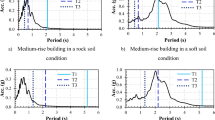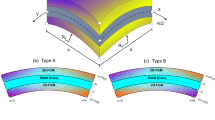Abstract
SPO2FRAG (Static PushOver to FRAGility) is introduced, a MATLAB®-coded software tool for estimating structure-specific seismic fragility curves of buildings, using the results of static pushover analysis. The SPO2FRAG tool (available online at http://wpage.unina.it/iuniervo/doc_en/SPO2FRAG.htm) eschews the need for computationally demanding dynamic analyses by simulating the results of incremental dynamic analysis via the SPO2IDA algorithm and an equivalent single-degree-of-freedom approximation of the structure. Subsequently, fragility functions may be calculated for multiple limit states, using the intensity-measure-based analytical approach. The damage thresholds may also be random variables and uncertainty in estimation of the fragility parameters may be explicitly accounted for. The research background underlying the various modules comprising SPO2FRAG is presented together with an operational description of how the various functions are integrated within the software’s graphical user interface. Two illustrative SPO2FRAG applications are also offered, using a steel and a reinforced concrete moment resisting frame. Finally, the software’s output is compared with the results of incremental dynamic analysis as validation of SPO2FRAG’s effectiveness.














Similar content being viewed by others
References
Adam C, Ibarra LF (2015) Seismic collapse assessment. In: Beer M, Kougioumtzoglou IA, Patelli E, Siu-Kui Au I (eds) Earthquake engineering encyclopedia, vol 3. Springer, Berlin, pp 2729–2752
Akkar S, Bommer JJ (2010) Empirical equations for the prediction of PGA, PGV and spectral accelerations in Europe, the Mediterranean region and the Middle East. Seismol Res Lett 81(2):195–206
ASCE (2000) FEMA-356: prestandard and commentary for the seismic rehabilitation of buildings. Developed by ASCE for FEMA, Washington, DC
ASCE (2007) Seismic rehabilitation of existing buildings. ASCE/SEI 41-06, Reston
Baker JW (2015) Efficient analytical fragility function fitting using dynamic structural analysis. Earthq Spectra 31(1):579–599
Baltzopoulos G, Chioccarelli E, Iervolino I (2015) The displacement coefficient method in near-source conditions. Earthq Eng Struct Dyn 44(7):1015–1033
Barani S, Spallarossa D, Bazzurro P (2009) Disaggregation of probabilistic ground-motion hazard in Italy. Bull Seismol Soc Am 99:2638–2661
Barani S, Spallarossa D, Bazzurro P (2010) Erratum to disaggregation of probabilistic ground-motion hazard in Italy. Bull Seismol Soc Am 100:3335–3336
Bazzuro P, Cornell CA, Shome N, Carballo JE (1998) Three proposals for characterizing MDOF non-linear seismic response. J Struct Eng 124:1281–1289
BSSC (1997) FEMA-273: NEHRP guidelines for the seismic rehabilitation of buildings. Developed by ATC for FEMA, Washington, DC
Calvi GM, Pinho R, Magenes G, Bommer JJ, Restrepo-Vélez LF, Crowley H (2006) Development of seismic vulnerability assessment methodologies over the past 30 years. ISET J Earthq Technol 43(3):75–104
CEN (2004) EN 1998-1 design of structures for earthquake resistance—Part 1: general rules seismic actions and rules for buildings. European Committee for Standardization, Brussels
Cornell CA, Krawinkler H (2000) Progress and challenges in seismic performance assessment. PEER Center News 3(2):1–3
Cornell CA, Jalayer F, Hamburger RO, Foutch DA (2002) The probabilistic basis for the SAC/FEMA steel moment frame guidelines. J Struct Eng 128:526–533
De Luca F, Vamvatsikos D, Iervolino I (2013) Near-optimal piecewise linear fits of static pushover capacity curves for equivalent SDOF analysis. Earthq Eng Struct Dyn 42(4):523–543
Dolsek M (2009) Incremental dynamic analysis with consideration of modelling uncertainties. Earthq Eng Struct Dyn 38(6):805–825
Efron B (1982) The jackknife, the bootstrap and other resampling plans. In: CBMS-NSF, regional conference series in applied mathematics, Society for industrial and applied mathematics, Philadelphia, US
Fajfar P (2000) A nonlinear analysis method for performance based seismic design. Earthq Spectra 16(3):573–592
FEMA (2005) FEMA-440: improvement of nonlinear static seismic analysis procedures. Prepared by ATC for FEMA, Washington, DC
FEMA (2009) FEMA-P695: quantification of building seismic performance factors. Federal Emergency Management Agency, Washington, DC
FEMA (2012) FEMA-58-1: seismic performance assessment of buildings volume 1—methodology. Prepared by ATC for FEMA, Washington, DC
Fragiadakis M, Vamvatsikos D (2010) Fast performance uncertainty estimation via pushover and approximate IDA. Earthq Eng Struct Dyn 39(6):683–703
Fragiadakis M, Vamvatsikos D, Ascheim M (2014) Application of nonlinear static procedures for seismic assessment of regular RC moment frame buildings. Earthq Spectra 30(2):767–794
Han SW, Moon K, Chopra AK (2010) Application of MPA to estimate the probability of collapse of structures. Earthq Eng Struct Dyn 39:1259–1278
Haselton CB, Deierlein GG (2007) Assessing seismic collapse safety of modern reinforced concrete moment-frame buildings. PEER report 2007/08. Pacific Earthquake Engineering Center University of California, Berkley
Haselton CB, Liel AB, Deierlein GG, Dean BS, Chou JS (2011) Seismic collapse safety of reinforced concrete buildings. I: assessment of ductile moment frames. J Struct Eng 137(4):481–491
Ibarra LF, Medina RA, Krawinkler H (2005) Hysteretic models that incorporate strength and stiffness deterioration. Earthq Eng Struct Dyn 34:1489–1511
Iervolino I, Cornell CA (2005) Record selection for nonlinear seismic analysis of structures. Earthq Spectra 21(3):685–713
Iervolino I, Baltzopoulos G, Vamvatsikos D, Baraschino R (2016a) SPO2FRAG v1.0: software for PUSHOVER-BASED derivation of seismic fragility curves. In: Proceedings of the VII European congress on computational methods in applied sciences and engineering, ECCOMAS, Crete Island, Greece, 5–10 June
Iervolino I, Chioccarelli E, Cito P (2016b) REASSESS V1.0: a computationally-efficient software for probabilistic seismic hazard analysis. In: Proc. of VII European congress on computational methods in applied sciences and engineering, ECCOMAS, Crete Island, Greece, 5–10 June
Jalayer F, Cornell CA (2003) A technical framework for probability-based demand and capacity factor design (DCFD) seismic formats. PEER Report 2003/08, Pacific Earthquake Engineering Center, University of California, Berkley
Katsanos EI, Vamvatsikos D (2017) Yield frequency spectra and seismic design of code-compatible RC structures: an illustrative example. Earthq Eng Struct Dyn (in press)
Krawinkler H, Seneviratna GDPK (1998) Pros and cons of a pushover analysis of seismic performance evaluation. Eng Struct 20(4–6):452–464
Kwong NS, McGuire RK, Chopra AK (2015) A framework for the evaluation of ground motion selection and modification procedures. Earthq Eng Struct Dyn 44(5):795–815
Lignos DG, Krawinkler H (2011) Deterioration modelling of steel components in support of collapse prediction of steel moment frames under earthquake loading. J Struct Eng 137(11):1291–1302
Luco N, Cornell CA (2007) Structure-specific scalar intensity measures for near-source and ordinary earthquake ground motions. Earthq Spectra 23(2):357–392
McKenna F, Fenves GL, Scott MH, Jeremic B (2000) Open system for earthquake engineering simulation (OpenSees). Pacific Earthquake Engineering Research Center, University of California, Berkeley
Meletti C, Galadini F, Valensise C, Stucchi M, Basili R, Barba S, Vannucci G, Boschi E (2008) A seismic source zone model for the seismic hazard assessment of the Italian territory. Tectonophysics 450:85–108
Moehle JP (1992) Displacement-based design of RC structures subject to earthquakes. Earthq Spectra 8(3):403–428
Mood AM, Graybill FA, Boes DC (1974) Introduction to the theory of statistics. Mc-Graw Hill, New York
NIST (2010) Evaluation of the FEMA P-695 methodology for quantification of building performance factors. Report No. NIST GCR 10-917-8. Prepared for the US National Institute of Standards and Technology by the NEHRP Consultants Joint Venture, Gaithersburg, MD
SEAOC (1995) VISION 2000: performance based seismic engineering of buildings, San Francisco
Shome N, Cornell CA (1999) Probabilistic seismic demand analysis of nonlinear structures. Doctoral Dissertation, Stanford University, CA
Vamvatsikos D (2014) Seismic performance uncertainty estimation via IDA with progressive accelerogram-wise latin hypercube sampling. J Struct Eng 140(8):A4014015
Vamvatsikos D, Cornell CA (2002) Incremental dynamic analysis. Earthq Eng Struct Dyn 31:491–514
Vamvatsikos D, Cornell CA (2004) Applied incremental dynamic analysis. Earthq Spectra 20(2):523–553
Vamvatsikos D, Cornell CA (2005) Direct estimation of seismic demand and capacity of multiple-degree-of-freedom systems through incremental dynamic analysis of single degree of freedom approximation. J Struct Eng 131:589–599
Vamvatsikos D, Cornell CA (2006) Direct estimation of the seismic demand and capacity of oscillators with multi-linear static pushovers through IDA. Earthq Eng Struct Dyn 35:1097–1117
Vamvatsikos D, Fragiadakis M (2010) Incremental dynamic analysis for estimating seismic performance uncertainty and sensitivity. Earthq Eng Struct Dyn 39(2):141–163
Vidic T, Fajfar P, Fischinger M (1994) Consistent inelastic design spectra: strength and displacement. Earthq Eng Struct Dyn 23:507–521
Zareian F, Medina R (2010) A practical method for proper modeling of structural damping in inelastic plane structural systems. Comput Struct 88(1–2):45–53
Acknowledgements
The work presented in this paper was developed within the AXA-DiSt (Dipartimento di Strutture per l’Ingegneria e l’Architettura, Università degli Studi di Napoli Federico II) 2014–2017 research program, funded by AXA-Matrix Risk Consultants, Milan, Italy. ReLUIS (Rete dei Laboratori Universitari di Ingegneria Sismica) is also acknowledged.
Author information
Authors and Affiliations
Corresponding author
Rights and permissions
About this article
Cite this article
Baltzopoulos, G., Baraschino, R., Iervolino, I. et al. SPO2FRAG: software for seismic fragility assessment based on static pushover. Bull Earthquake Eng 15, 4399–4425 (2017). https://doi.org/10.1007/s10518-017-0145-3
Received:
Accepted:
Published:
Issue Date:
DOI: https://doi.org/10.1007/s10518-017-0145-3




